|

A Wonderful Weekend
'Tosca' and 'Mikado' in Arizona,
enjoyed by MARIA NOCKIN
Most Arizona opera goers attend five performances a year in their home state. A weekend that allows them to see two shows on consecutive nights is highly unusual, but on 14 and 15 November 2008, it was possible for anyone who could get to both Phoenix and Tucson. Phoenix Opera, a company that gave its first performance last year, presented Puccini's Tosca at the Orpheum Theatre on Friday evening and the well-established Arizona Opera gave Gilbert and Sullivan's The Mikado in Tucson the next night. It was a true feast for devotees of the art.
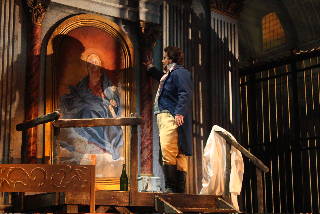
Jon Burton as Mario Cavaradossi in Tosca at Phoenix Opera. Photo © 2008 Victor Massaro
|
The opera Tosca has a libretto based on the French play, La Tosca, written for Sarah Bernhardt by Victorien Sardou. It was first staged in Paris in 1887 and Puccini probably saw it when it was presented in Milan the same year. He immediately asked his publisher, Giulio Ricordi, to secure the rights for him, but it did not happen. Ricordi did not buy those rights until 1893 when he wanted Alberto Franchetti to compose it. The following year Franchetti, librettists Luigi Illica and Giuseppe Giacosa, publisher Giulio Ricordi along with the world famous composer Giuseppe Verdi went to visit Sardou. Verdi said he would compose Tosca if the ending were changed! The librettists were not fond of the ending either, but Sardou would not agree to their changes. The play's finale was a problem in a number of places. It was actually done differently in New York where Tosca did not jump. Instead, the soldiers had to shoot her.
Franchetti worked on the opera for a few months but then gave up. At that point Ricordi called in Puccini who was understandably offended at not having been asked earlier. He waited for some months, but once his La bohème was going from theatre to theatre, he began to compose Tosca, a story he had wanted to use for some years. He worked and often fought with Illica and Giacosa but they finished the libretto late in 1899. This opera, which is set in Rome, had a most successful première at that city's Teatro Costanzi on 14 January 1900.
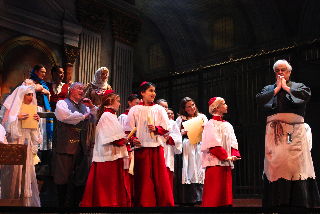
Michael Gallup as the Sacristan. Photo © 2008 Victor Massaro
|
Phoenix Opera's Tosca was a traditional rendition of the well-known piece that was ecstatically received by its audience. Robert Little's sets, originally built for Tri-Cities Opera of Binghamton, New York, were functional, decorative and definitively established the time and the place as Rome in the year 1800. With the single exception of the leading lady's somewhat nondescript first act dress, Tri-Cities' costumes were equally accurate as to time and place.
Anthony Laciura's adroit and purposeful stage direction enabled the singers to create memorable portrayals. Argentine soprano Fabiana Bravo was a passionate Tosca who lit up the stage with her charisma. She gave unstintingly of her vocal gifts and engaged the audience with her exciting interpretation. As Cavaradossi, Jon Burton showed strong acting ability and sang with a secure, fluid line. His final act rendition of 'E lucevan le stelle' (The stars were shining) was particularly poignant and brought tears to many eyes in the audience.
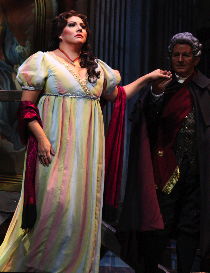
Fabiana Bravo as Floria Tosca and Mauro Augustini as Baron Scarpia. Photo © 2008 Victor Massaro
|
Italian baritone Mauro Augustini was a fearsome Scarpia with a dark, ominous vocal sound. He was outstanding in the 'Te Deum' and a truly malicious opponent of the lovers in Act II. Michael Gallup was an amusingly alcoholic Sacristan. Scarpia's henchmen, Spoletta and Sciarrone, sung by Daniel Kurek and Philip Skinner, also created believable cameo characterizations in this performance. Skinner was a convincing Angelotti, as well, while Jeffrey Stevens was a commendable jailer.
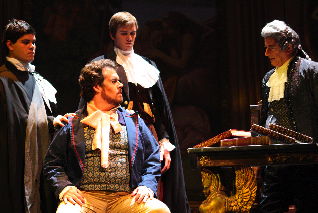
Jon Burton as Mario Cavaradossi and Mauro Augustini as Baron Scarpia. Photo © 2008 Victor Massaro
|
The glue that holds an operatic performance together is the conducting. John Massaro kept the tempi flowing and never let the tension sag. His orchestra played well and executed some truly beautiful solo passages. At the end of the evening there were copious bows greeted by a vociferously enthusiastic audience.
On Saturday evening, opera lovers came to Tucson for the ninth of Gilbert and Sullivan's collaborations, The Mikado, or the Town of Titipu. This comic opera succeeds in satirizing British politics and conventions of the Victorian era, which are only slightly disguised by the work's Japanese setting. It was written when Europe was just beginning to trade with Japan and it took advantage of English curiosity about the Far East when it was premièred at the Savoy Theatre in London on 14 March 1885.
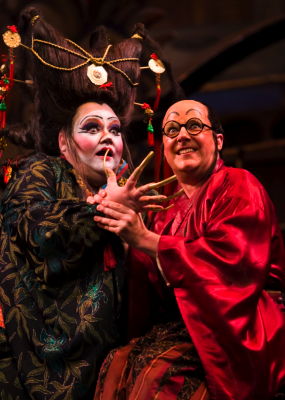
Stephanie Blythe as Katisha and Neal Davies as Ko-Ko in Arizona Opera's 'The Mikado'. Photo © 2008 Tim Fuller
|
Sir Arthur Sullivan had told his librettist, William Schwenk Gilbert, that he was tired of composing opera, especially the kind that told unrealistic stories. Gilbert then put aside a story that involved a love potion contained in a lozenge and wrote the original scenario for the much more credible Mikado. Ten months later it reached the London stage. He said he set it in Japan because of the opportunities that culture offered for a picturesque setting.
Arizona Opera gave us an outstanding cast. The contralto role of Katisha was sung by the incomparable Metropolitan Opera mezzo-soprano, Stephanie Blythe, and the other leading singers were almost equally accomplished. Patrick Miller was a handsome Nanki-Poo who sang with a robust, luminous sound. As his beautiful sweetheart, Yum-Yum, Ann-Carolyn Bird combined visual spectacle with dramatic coherence as she sang with stunningly clear, sweet tones. Her companions Peep-Bo and Pitty-Sing were artfully interpreted by Tamara Mesic and Olga Perez.
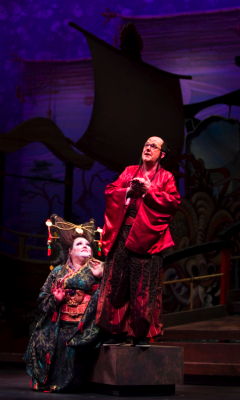
Stephanie Blythe as Katisha and Neal Davies as Ko-Ko in Arizona Opera's 'The Mikado'. Photo © 2008 Tim Fuller
|
Baritone Daniel Sumegi sang Pooh-Bah's low tones with ease as he created a most interesting character. This Pooh-bah, along with Pish-Tush sung by sonorous baritone Corey McKern and Ko-Ko portrayed by smooth sounding bass-baritone Neal Davies, managed to satirize the politics of today as well as that of the Victorian era.
As Katisha, Blythe does not appear until the end of the first act, but she made a grand entrance on a dragon boat wearing a huge headdress and enormous fingernails reminiscent of Birgit Nilsson's Met Turandot costume. She also proved that a great singer with enthralling low tones can also be a hilariously funny comedienne. Smaller parts interpreted by David Smith-Larsen and Curt Olds added to the mix, as did the wonderful acrobats who performed incredible feats in the air.
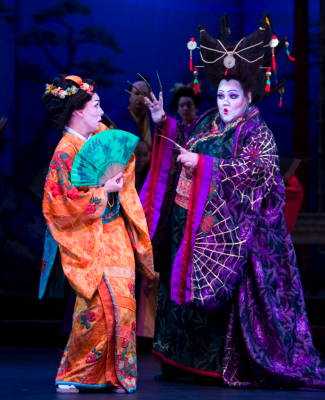
Anne-Carolyn Bird as Yum-Yum and Stephanie Blythe as Katisha. Photo © 2008 Tim Fuller
|
Kelly Robinson's stage direction kept the action moving at a fast pace and all the disparate parts of this complicated piece fell into place with seamless precision. Julian Reed's chorus sang with vigorous tones and helped keep the plot flowing with pertinent action. Conductor Joel Revzen drew transparent playing from the orchestra with his light but propulsive approach to the music. He allowed the soloists breathing room, but never lost his masterly feeling for line of this Sullivan masterpiece.
This was the climax of a wonderful weekend in Arizona and the Tucson audience thanked their opera company with a long and heartfelt standing ovation.
Copyright © 23 November 2008
Maria Nockin, Arizona USA

| 
